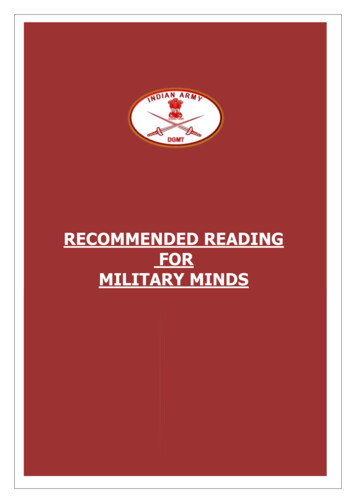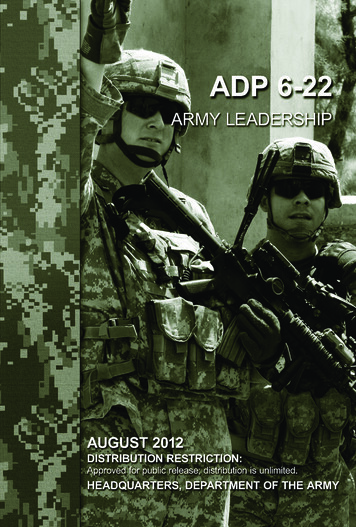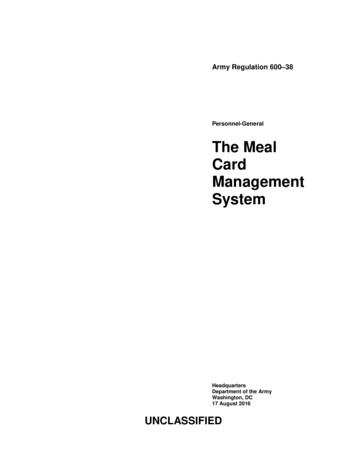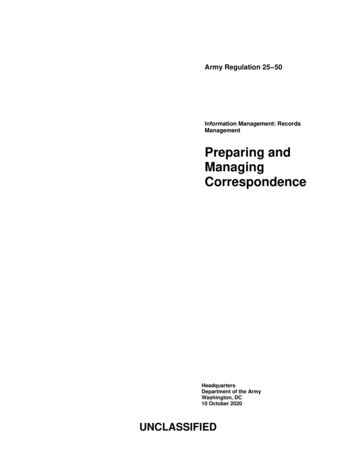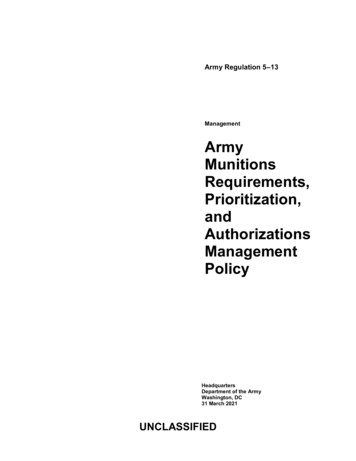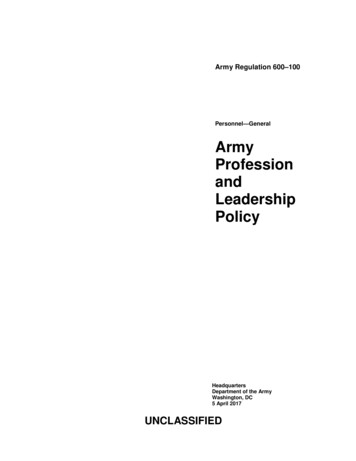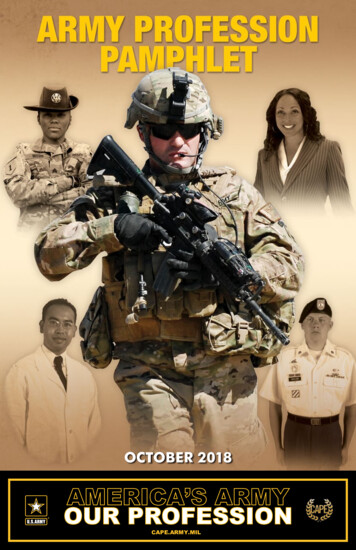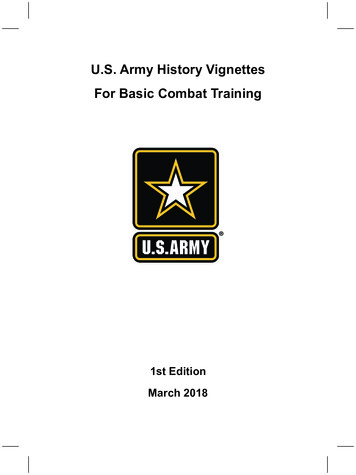
Transcription
U.S. Army History VignettesFor Basic Combat Training1st EditionMarch 2018
Table of ContentsRed PhaseAmerican Revolu on and the Early Years of the Republic:Winning and Maintaining Our Na onal IndependenceDelaware and TrentonValley ForgeCowpensNew OrleansCivil War: Preserving the Na on and Libera ng theOppressedGe ysburgVicksburgWWI: Defea ng Interna onal AggressionMeuse‐Argonne OffensiveArdennes ForestWWII: Anvil of VictoryOmaha Beach, NormandyThe Ba le of LeyteBa le of the BulgeHacksaw Ridge
Delaware and Trenton: After several months of tactical defeats, General Washington realized that without decisive action, theContinental Army was likely doomed. Running out of viable options, he planned a daring, and successful assault on the Hessiangarrison at Trenton.Hero of the Battle: General (GEN) George Washington; Continental Army. With weather conditions being dire, morale being low,and lacking proper equipment, the Continental Army, led by GENWashington, crossed the icy Delaware River and began its marchon the city of Trenton on Christmas day 1776. The American attack commenced on the morning of 26 December and by noonWashington’s force had moved back across the Delaware Riverinto Pennsylvania, taking their prisoners and captured supplies withthem.Central Message: Soldiers are disciplined, mentally and physically tough.1
Valley Forge: On December 19th, 1777, General Washington led12,000 Soldiers to their winter encampment at Valley Forge, Pennsylvania. GEN Washington’s Soldiers trudged into camp, their feetbloody from a lack of proper footwear and hundreds of milesmarched during a long campaign season. Though the Soldierswere half-starved, ill-equipped and poorly clothed, they perseveredand received intense training and discipline. On June 19th, 1778,six months after arriving at Valley Forge, the Continental Armypursued the British forces who were moving towards New YorkCity. Washington’s Soldiers engaged the British at the Battle ofMonmouth. Strengthened by the hardships they had already overcome and the training they had received, the Americans defeatedthe British and prevented the attack on New York.Hero of the Battle: General (GEN) George Washington; Continental Army. While at Valley Forge, General Washington greatlyenhanced the discipline, training, supply and morale of his Soldiersin part because he shared the hardships they all faced, ensuringthat the Continental Army emerged as the professional fightingforce that he would lead to victory over the British, thus securingAmerican independence.Central Message:mentally tough.Soldiers are disciplined, physically and2
Cowpens: On January 17th, 1781, British forces attacked Americanmilitia and regular positions near Cowpens, South Carolina. TheBritish Commander, having little regard for the abilities, discipline ortraining of the American force, massed his forces in a frontal assault.But the American Soldiers were well-prepared, and they envelopedthe British Forces, resulting in an overwhelming American victory.Hero of the Battle: Lieutenant Colonel (LTC) John Eager Howard, 5th Maryland Regiment, Continental Army. Commanding theContinental forces during the battle, LTC Howard baited the advancing British to pursue him up rising ground. Once the Americansachieved the full advantage of the high ground, Howard ordered hismen to turn and fire, stunning the British lines. Howard then ordereda bayonet charge that thoroughly routed the enemy and ensuredvictory. For his actions, he was awarded the Congressional SilverMedal.Central Message: Soldiers are members of the Total Army team.3
The Battle of New Orleans: A series of engagements foughtbetween December 1814 and January 1815, constituting the lastmajor battle of the War of 1812. After defeating Napoleon in Europe earlier that year, Great Britain redoubled its efforts against itsformer colonies. If Great Britain could seize New Orleans, it wouldgain dominion over the Mississippi River and hold trade of the entireAmerican South under its thumb.Hero of the Battle: Major General (MG) Andrew Jackson; 7thMilitary District, U.S. Army. Although the American forces, underMG Jackson, were vastly outnumbered, the Battle of New Orleanswas remarkable for both its brevity and lopsided lethality, with atotal loss of British soldiers estimated at 2,600, and American losses at less than 100.Central Message: Soldiers never accept defeat and never quit.4
Gettysburg: On the second day of the Battle of Gettysburg,Union forces were recovering from initial setbacks and hastilyregrouped into defensive positions on a line of hills South of thetown. Sensing a momentary vulnerability of the Union forces, theConfederates began an attack against the Union left flank.Hero of the Battle: Colonel (COL) Joshua Chamberlain; Commander of the 20th Maine Regiment, Union Army. During theattack, COL Chamberlain quickly understood the strategic significance of holding the small hill (later known as Little Round Top).With many casualties and low ammunition, COL Chamberlainordered his left wing to initiate a bayonet charge which he ledhimself, thus saving the flank and holding the position for the Union Army.Central Message: Soldiers always place the mission first.5
Vicksburg: The Battle of Vicksburg was the culmination of along land and naval campaign by Union forces to capture a key strategic position during the Civil War. President Lincoln recognized thesignificance of the town and said that, “Vicksburg is the key, the warcan never be brought to a close until that key is in our pocket.”Hero of the Battle: Private (PVT) Uriah Brown, 30th Ohio Infantry, Union Army. During the Battle of Vicksburg, despite the death ofhis captain at his side during an assault, he continued carrying a logto the defense ditch. While he was laying the log into position he wasshot along with several of his comrades. Despite his wounds andintense fire, PVT Brown dragged 5 of the other wounded Soldiersfrom the ditch and put them in a place of safety.Central Message: Soldiers never leave a fallen comrade.6
Meuse-Argonne Offensive: In October 1918, the Allied Expeditionary Force conducted the last major offensive of World War I(WWI). It was one of the largest American military operation in history, involving more than 1.2 million Soldiers. American forcesfought from trenches, across barbed wire, and through dense forests to defeat the heavily fortified enemy. The campaign was asuccess and led directly to an Allied victory in WWI.Hero of the Battle: Sergeant (SGT) Alvin York; 328th Infantry,82nd Division. SGT York was one of the most decorated Soldiers ofWWI. He led an attack on a series of German machinegun nests,capturing 35 machineguns, defeating 25 enemy personnel, andtaking 132 prisoners. For his actions, he was awarded the Medal ofHonor.Central Message: Soldiers always place the mission first.7
Ardennes Forest: Attack on Hill 188, Champagne Marne Sector, France, WWI. By the fall of 1918, the Central Powers wereunraveling on all fronts, and during the Meuse-Argonne Offensive,Corporal (CPL) Stowers’ unit was tasked with attacking Hill 188, keyterrain in his unit’s assigned sector.Hero of the Battle: CPL Freddie Stowers; 371st Infantry Regiment, 93rd Infantry Division (Colored). On September 28, 1918,after only a few minutes into the attack on Hill 188, the enemyceased fire and began climbing out of the trenches with their handsup as if to surrender. As CPL Stowers’ moved forward within 100meters, the enemy jumped back into the trenches and opened upwith interlocking bands of machine gun and mortar fire causing wellover 50% casualties to Stowers’ unit. CPL Stowers took chargeand inspired the remaining men to follow him in the attack. Duringthis attack, CPL Stowers was mortally wounded, but still pressedforward urging on the members of his squad until he died, inspiringhis entire company to press the attack until Hill 188 was captured.For his actions that day, he was posthumously awarded the Medalof Honor.Central Message: Soldiers never accept defeat and never quit.8
Omaha Beach, Normandy: On June 6th, 1944, American and alliedforces crossed the British Channel and attacked the fortified Germanpositions in Normandy, France. American Soldiers at Omaha Beachused individual movement techniques to negotiate mines, fortifications, and various other obstacles in order to defeat the enemy.Their dedication and fortitude ensured victory in the most importantbattle of World War II.Hero of the Battle: Technician 5th Grade John Pinder; 16th InfantryRegiment, 1st Infantry Division. During the invasion, TechnicianPinder was responsible for carrying vital communications equipmentto shore. He was wounded almost immediately, but continued tobrave machinegun and sniper fire to move equipment from the surf tothe beach. He was wounded twice more, but refused medical treatment. He died of his wounds, but not before establishing a criticalcommunications link for the invasion force. For his actions, he wasawarded the Medal of Honor.Central Message: Soldiers are trained and proficient in theirWarrior Tasks and Battle Drills.9
Battle of the Bulge: In December 1944, more than 200,000German troops and nearly 1,000 tanks launched a counteroffensive that was intended to cut through the Allied forces in amanner that would turn the tide of the war in Germany’s favor.Hero of the Battle: Sergeant (SGT) Jose Lopez; 23rd Infantry,2nd Infantry Division. During a German attack during the Battle ofthe Bulge, SGT Lopez’s company was about to be flanked by theadvancing German infantry. SGT Lopez moved his heavy machinegun to the company’s flank and single handedly cut down over 100advancing German soldiers ensuring his company was not enveloped and allowing it to withdraw successfully, which gave otherforces time to build a line and repel the enemy drive. For his actions, he was awarded the Medal of Honor.Central Message: Soldiers are proficient in their WarriorTasks and Battle Drills.10
The Battle of Leyte: The amphibious invasion of the Gulf of Leytein the Philippines in late 1944 aimed to recapture and liberate theentire Philippine Archipelago after nearly three years of Japaneseoccupation. For the U.S., capturing the Philippines was a key strategic step in isolating Imperial Japan’s hold on the Pacific theater.Hero of the Battle: Private First Class (PFC) Dirk Vlug; 126thInfantry Regiment, 32nd Infantry Division. PFC Vlug was manning aroadblock on the Ormoc Road when his unit was attacked by heavilyarmed Japanese tanks. Reacting on instinct, PFC Vlug armed himselfwith a bazooka and 6 rounds of ammunition before charging the tanks.He single-handedly destroyed all 5 tanks. For his actions that day, hewas awarded the Medal of Honor.Central Message: Soldiers are proficient in their Warrior Tasksand Battle Drills.11
Hacksaw Ridge: In May of 1945, the 77th Division was engaged incombat on the Japanese island of Okinawa. The unit took heavycasualties while fighting in caves and along ridgelines, but the Division was able to seize the key terrain, and Army medics proved crucial in the saving and evacuation of wounded Americans.Hero of the Battle: Private First Class (PFC) Desmond Doss;307th Infantry, 77th Infantry Division. Army medic PFC Doss, whorepeatedly risked his life to save fallen comrades, and though he waswounded four times, kept treating and moving wounded Soldiers tosafety. He saved the lives of at least 75 American Soldiers. For hisactions, he received the Medal of Honor.Central Message: Soldiers never leave a fallen comrade.12
Produced by theUnited States ArmyCenter for Initial Military TrainingIn conjunction with theTRADOC Military History Officeand theUnited States ArmyCenter for Military History
Continental Army was likely doomed. Running out of viable op-tions, he planned a daring, and successful assault on the Hessian garrison at Trenton. Hero of the Battle: General (GEN) George Washington; Conti-nental Army. With weather conditions being dire, morale being low, and lacking proper equipment, the Continental Army, led by GEN


